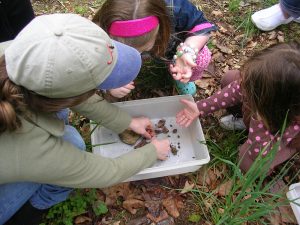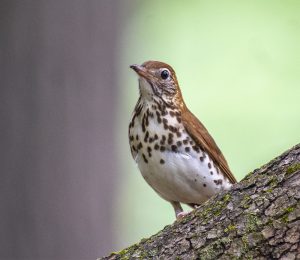Discovering Nature with Kids
You may learn more than you expected if you take along a curious companion
If you’ve ever spent more than three minutes with a kid, you know that they’re natural explorers with an innate curiosity. While this natural curiosity can sometimes lead to a never-ending barrage of questions (think “Why?”, “Why?”, “Why?” and the follow-up “Why?”), it can also result in discoveries and connections that will last a lifetime.
This season spend time with the children in your life to create opportunities for them to embrace their sense of wonder—and to rekindle yours!
Adults as Guides
 When spending time with kids in nature, think of yourself as a guide rather than a teacher. Contrary to popular belief, adults don’t have to know everything or be an expert. You just have to be willing to explore and discover right alongside the kids!
When spending time with kids in nature, think of yourself as a guide rather than a teacher. Contrary to popular belief, adults don’t have to know everything or be an expert. You just have to be willing to explore and discover right alongside the kids!
So many simple activities can lead to discovery. The best course is simply to allow kids to choose what to explore and see where that takes you. Notice what they gravitate towards and are getting excited about.
Next, sprinkle in some open-ended questions. “What are you looking at? What did you find? What do you think it looks like?” Keep observing and asking questions together.
Venues for Exploration
 Venturing outside doesn’t have to entail a full-day road trip. The Philadelphia area—known as the Garden Capital, with 36 gardens within 30 minutes—is rich with outdoor spaces that are free to visit, including Jenkins Arboretum & Gardens in Devon.
Venturing outside doesn’t have to entail a full-day road trip. The Philadelphia area—known as the Garden Capital, with 36 gardens within 30 minutes—is rich with outdoor spaces that are free to visit, including Jenkins Arboretum & Gardens in Devon.
Short on time? Go for a walk in your neighborhood or explore in your own backyard or porch.
But before you step foot out the door for your adventure, set yourself up for success. Play clothes are called play clothes for a reason.Wear them from head to toe (even adults!) and bring back-ups. Water and snacks go a long way too. And something to wipe hands after everyone holds the worm you find.
Using Your Senses
Engaging your senses is one of the best ways to connect with nature. Here are some simple ideas to help foster curiosity this season.
- Sight – Use your eyes to look closely at what’s around you. Change your perspective and observe what’s down low on the ground and up high in the sky. Go on a color hunt with paint samples from the hardware store or download one of Jenkins’ Nature Bingo or Nature Detectives activity sheets on our website. Bring along a magnifying glass or binoculars to augment your sense of sight.
- Sound – Listening carefully helps us find things in nature that we might not be able to see. Go on a quiet walk and count how many different sounds you hear. Remember, you don’t need to be able to identify every sound, but this starts a discussion about what might have made that sound. Was it buzzing or chirping or rattling? Even just listening to the wind with your eyes closed is a wonderful activity. If you want to make the noises of nature even louder, cup your hands behind your ears and push your ears forward ever so slightly to increase your ability to hear. Are you trying it right now?
- Smell – The sense of smell is closely linked with memories, so start making some positive connections! There are so many seasonal smells to get a whiff of throughout the year. Many flowers produce sweet scents to enjoy. Some leaves, including many common herbs, are “scratch and sniff” and have a pleasing aroma when gently rubbed between your fingers. Ready to learn a new vocab word? Petrichor. It’s that wonderful, earthy smell that often comes after a rainstorm. Next time it rains, pull on those boots and try to smell the petrichor!
- Touch – There are tons of textures to feel outdoors. Go on a texture tour and find things that are smooth, rough, hard, soft, bumpy, lumpy and much more. Get your hands dirty squishing mud and then wash them off in the wet grass. Walk up to a tree and feel the bark or rub the fuzzy leaves of lamb’s ear. Always be respectful when handling any wildlife and be a bit cautious with touching leaves. Be on the lookout for poison ivy (leaves of three, let them be) and stinging nettle (look at the stalks). Touch can also lead to lessons on how to be respectful outdoors, regarding picking and collecting samples on others’ property or in public gardens.
- Taste – This is the trickiest sense of all because it’s not safe to taste most things outdoors. Taste is probably best suited for a home garden where you grow veggies or herbs. Kids are more apt to eat fresh foods that they’ve helped to grow themselves, so that’s an extra benefit of vegetable gardening. No garden, no problem! Take a walk around your local farmers market or produce aisle at the grocery store to create a taste test of local in-season fruit and vegetables.
Nature Journals and Photo Logs
 Now that you’ve ventured outside and have a plan for nature exploration, why not integrate a creative way to capture all your discoveries? You can start a nature journal to write and draw your sensory experience or create a photo log to keep track of your findings. Both activities document the shared memories that you’re making as you cultivate the next generation of environmental stewards.
Now that you’ve ventured outside and have a plan for nature exploration, why not integrate a creative way to capture all your discoveries? You can start a nature journal to write and draw your sensory experience or create a photo log to keep track of your findings. Both activities document the shared memories that you’re making as you cultivate the next generation of environmental stewards.
Fall and winter are wonderful seasons to get outside and engage your senses. Many plants go through dramatic changes once the cooler temperatures hit, so there are lots of differences to observe.
Make time to enjoy the season with the little ones in your life. You never know what you’ll discover together!
Jenkins Arboretum & Gardens is a community-supported public garden showcasing native flora of the eastern United States and a world-class collection of rhododendrons and azaleas. The gardens are open every day of the year, and admission is always free. 631 Berwyn Baptist Rd., Devon. 610-647-8870; JenkinsArboretum.org.
